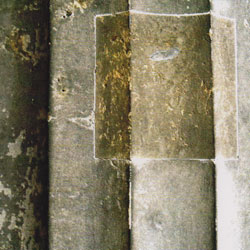
John Cage once said "I have found two ways of turning intention toward nonintention: musicircus (simultaneity of unrelated intentions); and music of contingency (improvisation using instruments in which there is a discontinuity between cause and effect)." As confusing as that may read, Cage's results are both indisputable (or cause enough ruckus to warrant "there must be something to this"), and these statements forge the beauty of much of his work, especially the latter days Number Pieces. Unhampered via ambiguous direction and offered choices — not explicit details — the pieces are as much about the performers and performance as the composer's idea(ls).
Despite several other stellar recordings of Four4, this quartet creates a wholly unique interpretation with a different generation's take on the subject. Lee Patterson's aesthetic is marked with amplified burning pinecones and vibrating steel tines (found discarded by street sweepers). Cellist Mark Wastell regularly works with electronic minimalist Kaffe Matthews, the Onkyo crew (Sachiko M, Toshimaru Nakamura etc.) and legends Evan Parker and John Butcher. Chris Burn is a pianist and deft interpreter of Henry Cowell and George Crumb, known specifically for his virtuosity inside the lid. And drummer Simon Allen is (if my research is accurate) steeped in Morton Feldman and / or Northern Ireland alt-country folk scene. But here they gather as "percussionists", pooling their resources for 74 minutes, cheating the idiosyncratic expectations of their instruments through a host of methods to produce sustained, passing sonic clouds. On Part 1, a deep pulsing groan, accompanied by subtle tam tam strikes, abruptly begins and ends. This is replaced by synthetic-seeming, gurgling wind chimes, and then trumped by a long noisy paradiddle on a cymbal. Like a light-switch, everything halts into a pregnant pause, resuming thirty seconds later with a flaring purr and thumping hand crank (or a chopstick across bike spokes?) During the twenty-minute track, the group adds a few more colors and re-sequences the order and length of each segment — and with very little variation creates a heightened, hypnotic pressure. Per the score, each member focuses on each of their pre-selected groups of sounds, never attempting to mesh; but the crossroad moments stack astonishing textures of dilatory counterpoint.
Something must be mentioned about the amount of "silence", of which there is ample throughout the piece. In the score, Cage advises, "Whenever there is no activity, simply listen, as listeners to the finished recording will, hearing the sounds wherever they are." And this we do, throughout, one of the more striking examples being the gaping hole between the furious rattle (rubbed metal) and (gong) roll toward the end of Part 2 and Burn's muted hammer arpeggios near the beginning of Part 3. The flip to Cage's statement is, during the spaces of this haunted mix, you begin to imagine things that aren't there, perhaps both mentally holding onto the previous extended gesture and anticipating the next.
Ultimately, it's just an admirable synergistic patience: 4' 33" was the catalyst but the impact of the relationships of blanks to landmarks in Four4 is the former's message in practice.
So what else is there to say about Cage's music? With dedicated musicians such as these, his legacy continues its evolving sprawl.
Comments and Feedback:
|



